How Much Is a Meteorite Worth?
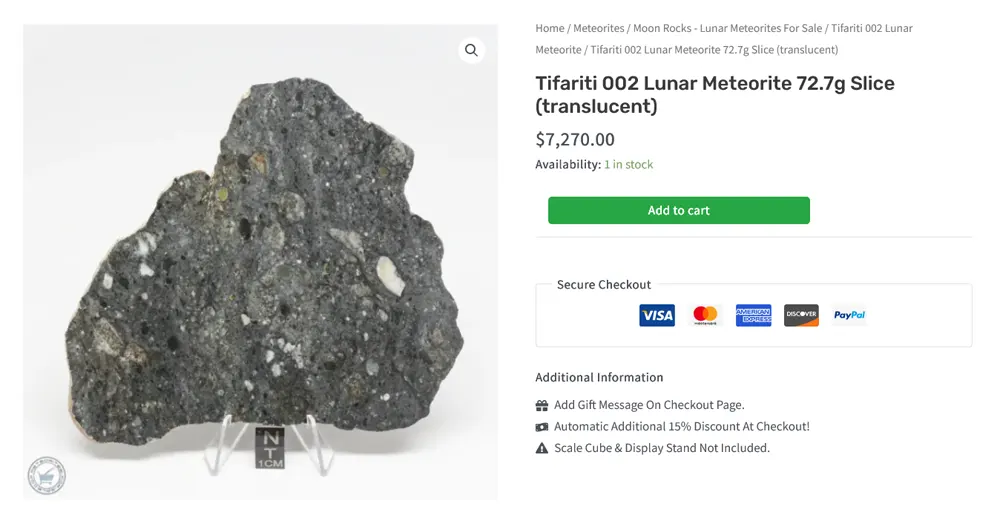
Are Meteorites Valuable? Understanding the worth of a meteorite can be enlightening. Space rocks hold not only monetary value but also scientific significance and rarity. Meteorite collectors and enthusiasts often seek to gauge the value of their specimens. Various factors come into play when determining how much are meteorite worth. In this article, we will explore these factors that answer the question how much do meteorite sell for, and how to establish a meteorite stone price. We will look at pricing models for different types of meteorites, and tips for both buying and selling these cosmic treasures.
Sometimes we are asked how much is a meteor worth? Or an individual will want to know the meteor rock value of a stone they have found. We will gently explain the terminology. Out in space the object is a meteoroid. When it is going through the atmosphere like shooting stars on a summer night it is a meteor. And when it hits the ground, it is a meteorite ready to find.
What Determines the Value of a Meteorite?
Factors Affecting Meteorite Worth
How much does a meteorite cost? The value of a meteorite is influenced by several specific factors. Rarity can play a crucial role. Common meteorite types may fetch a lower price compared to a meteorite of a rarer type. Other contributing aspects include the meteorite’s composition—iron meteorites typically have a different price point than stony meteorites. Additionally, the meteorite’s condition, such as whether it exhibits fusion crust or regmaglypts, can also impact its worth significantly. Collectors often seek well-preserved specimens, which are usually more valuable in the market. Many factors must be evaluated to answer the question, how much are meteorites worth.
The provenance of the meteorite can enhance its worth. If a meteorite is from a witnessed fall and can be traced back to the original finder, it often commands a higher price. The community of meteorite collectors value specimens that come with detailed documentation and verification. When assessing a meteorite’s worth, one should consider these many factors which contribute to meteorite value in the market.
Rarity and Demand in Meteorite Collecting
Rarity is another important factor in the meteorite price. Unique finds often draw significant interest from collectors. For example, Martian or lunar meteorites are exceptionally rare and can be valued at thousands of dollars per gram. The demand for these rare space rocks fuels their price. This creates a competitive market among enthusiasts and collectors. Common meteorites however, which are more readily available, generally have a lower market value compared to rare stone meteorites.
This dynamic between rarity and demand means that meteorite collectors must stay informed about market trends. As interest in space exploration and meteorite hunting increases, so does the potential value of rare specimens. Collectors should be aware of this fluctuation in demand, as it can affect how much they are willing to pay for particular meteorites, or how much they can expect to sell their own finds for.
Scientific Significance and Its Impact on Price
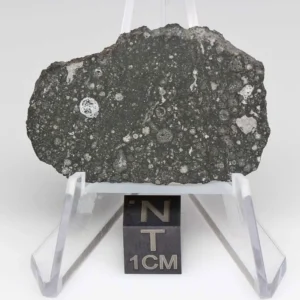
The scientific significance of a meteorite also influences its market value. Meteorites that provide insights into the formation of our solar system or contain unique minerals are highly sought after. For example, the Allende meteorite, a carbonaceous chondrite, contains presolar grains from beyond our solar system, and also tiny diamonds. Allende has been one of the most scientifically studied meteorites for decades. Collectors often pay a premium for specimens that offer scientific insight.
Meteorites that have been studied and classified by the scientific community usually have a more established price range. The classification process adds credibility and often increases the meteorite’s value. Collectors who own scientifically significant meteorites may find themselves in a favorable position when selling or trading their specimens.
How Much Are Meteorites Per Gram?
Understanding Meteorite Pricing Models
Meteorite pricing models can vary widely based on several factors, including the type of meteorite, its rarity, and whether it has been classified. Common meteorites may sell for anywhere between $0.50 to $5 per gram. However, prices can escalate dramatically for rare specimens. Martian meteorites can reach prices of $1,000 per gram or more, reflecting their scarcity, scientific importance and especially their known place of origin from the planet Mars.
Additionally, the pricing model is often influenced by current market trends and collector demand. As interest in meteorites fluctuates, prices can also fluctuate. Therefore, understanding these pricing models is valuable for both buyers and sellers. It enables them to make informed decisions based on the current market landscape and helps them gauge the true worth of their meteorites.
Comparing Prices of Different Types of Meteorites
When examining the prices of various types of meteorites, significant disparities become evident. Iron meteorites, for example, tend to have a different pricing structure compared to stony meteorites. While a common iron meteorite might cost around $1 to $10 per gram, unique or rare specimens might demand prices upwards of $50 per gram due to their historical significance or aesthetic appeal.
Stony meteorites, including achondrites and ordinary chondrites, can vary in price as well. Typical stony meteorites may range from $1 to $20 per gram, but certain rare finds can exceed this range. As collectors seek specific types of meteorites to add to their collections, understanding these price ranges becomes essential for making smart purchasing decisions and achieving fair sales. Meteorites-for-sale.com has pricing tools to view meteorites by price.
Market Trends for Rare Meteorites
The market for rare meteorites is continually evolving. As new discoveries are made and space missions generate interest in celestial materials, the demand for rare meteorites increases. This heightened interest can drive prices up, especially for specimens that have a compelling story or unique characteristics.
Collectors are often drawn to meteorites that have a documented history or those that are associated with significant scientific discoveries, particularly those from witnessed falls. When a meteorite fall occurs, there is a rush among some collectors to make sure they can acquire a specimen for their collection. Prices are often very high initially. If a large amount of the meteorite is later found the price will often fall significantly. The timing and availability of material are factors important in new meteorite falls. Reports in the media can also influence the price expectations of newly fallen meteorites. Collectors should keep a close eye on these factors to optimize their buying and selling strategies.
What Types of Meteorites Are Most Valuable?
Iron Meteorites vs. Stony Meteorites
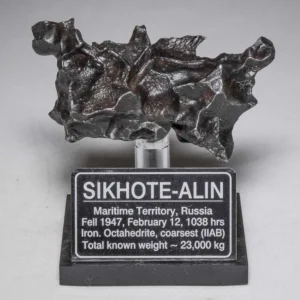
The value of meteorites can vary significantly between iron and stony types. An iron meteorite is sometimes more durable and easier to identify, making them popular among collectors. Iron meteorite value can range from $1 to $50
per gram, depending on their rarity, condition and aesthetics. Stony meteorites, which include both ordinary chondrites and rare achondrites, can also fetch high prices, particularly if they are well-preserved and have intriguing characteristics.
Collectors often favor stony meteorites for their diversity in composition and potential scientific value. While common stony meteorites may be relatively inexpensive, rare meteorite types can command much higher prices. Achondrite meteorite value will almost always be higher than most ordinary chondrite stone costs. This variability in pricing underscores the importance of understanding the specific type of meteorite when evaluating its market value.
Rare Finds: Martian and Lunar Meteorites
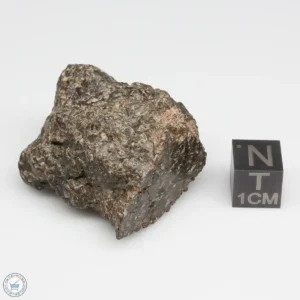
Martian and lunar meteorite are among the most coveted and most expensive meteorite finds in the meteorite collecting community. Their rarity and the scientific interest surrounding them contribute to their high market value. For instance, the Martian meteorite prices can exceed $1,000 per gram, while lunar meteorites may also reach similar price points due to their unique origins and the limited number of specimens available.
The allure of these planetary meteorites is not just their price but also the stories they tell about our solar system, including data about their origin on the Moon and Mars. Collectors are
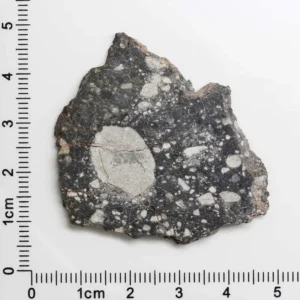
often willing to invest significant amounts for the opportunity to own a piece of another world. As new missions to Mars and the Moon continue to capture public interest, the value of these exceptional meteorites is likely to remain high, making them a worthy addition to any serious collection.
The Value of Pallasites
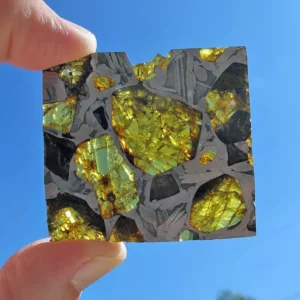
Pallasites, a unique type of stony-iron meteorite, are revered for their stunning appearance, characterized by their crystalline olivine gemstones embedded in a metallic matrix. Due to their aesthetic appeal and rarity, stony iron meteorite value can range anywhere from $50 to $500 per gram, depending on their quality and provenance. Collectors often seek these beautiful meteorites to enhance their collections with visually striking specimens.
How to Sell a Meteorite?
Steps to Take When You’ve Found a Meteorite
If you’ve discovered a meteorite, the first step is to properly document your find. This includes taking photographs and noting the location, date, and conditions surrounding the discovery. Next, it is advisable to conduct a preliminary meteorite identification, looking for common characteristics such as a fusion crust, regmaglypts, or nickel iron grains visible on a cut or ground surface. Once you have a better understanding of your specimen, consider seeking professional evaluation to ascertain its classification and value.
Our team at meteorites-for-sale.com no longer offers meteorite identification help. If you think you found a meteorite, please go to Geo Labs Meteorite Identification Service to submit a preliminary photo for evaluation. If the identification service confirms that your find is indeed a meteorite, the next step would be to have it laboratory classified.
Classifying your meteorite will help determine the value of your meteorite which is necessary for you to begin to explore selling options. Whether you choose to sell directly to dealers, collectors, or through online marketplaces, having a well-documented provenance and laboratory classification can increase your chances of achieving a favorable sale. Understanding the market trends for meteorites will also help you set a competitive price that reflects your specimen’s worth.
Where to List Your Meteorite for Sale
When it comes to selling your meteorite, there are various platforms available to reach potential buyers. Online marketplaces like meteorite-selling websites provide excellent opportunities to showcase your specimen to a global audience. In addition, social media platforms and collector forums allow you to connect with enthusiasts who might be interested in purchasing your meteorite.
If you have a properly classified meteorite you are selling, please fill out our We Buy Meteorites And Meteorite Collections form.
Tips for Pricing Your Meteorite
How much do meteorites sell for? Setting the right price for your meteorite is vital to a successful sale. Start by researching similar specimens to gauge their market value. Consider factors such as the meteorite’s type, condition, rarity, and any scientific significance it may hold. It can be beneficial to consult with experienced meteorite collectors or professionals in the field who can provide insight into pricing.
When determining your price, be realistic and open to negotiation. Buyers often appreciate a fair starting point, which can lead to successful transactions. If your meteorite has been laboratory classified and registered officially into the Meteoritical Bulletin, then offering a guarantee of authenticity and provenance can enhance your meteorite’s appeal and justify a higher price. By following these tips, you can effectively price your meteorite and increase your chances of making a sale.
What Should You Know About Meteorite Collecting?
Building a Valuable Meteorite Collection
Meteorite collecting requires a thoughtful approach and a keen understanding of what makes each specimen unique. Start by identifying your interests, whether you prefer rare finds, aesthetically pleasing specimens, or those with significant scientific value. Researching various types of meteorites, including iron, stony, and unique specimens like pallasites, will help you make informed decisions when building your collection.
As you acquire meteorites, focus on quality over quantity. A smaller collection of well-documented, high-quality specimens can be more valuable than a larger collection of common meteorites. Networking with other collectors and attending meteorite shows can also provide valuable insights and opportunities to acquire unique specimens to enhance your collection’s worth.
Key Resources for Meteorite Identification
Accurate meteorite identification is essential for collectors. Key resources include scientific literature, meteorite identification guides, and online databases that provide detailed information on various meteorite types. Additionally, joining meteorite collector groups or forums can help you connect with other experienced collectors.
Connecting with Other Meteorite Collectors
Connecting with fellow meteorite collectors is a rewarding aspect of this hobby. Engaging with a community of enthusiasts allows you to share knowledge, trade specimens, and gain insights into current market trends. Online forums and social media groups dedicated to meteorite collecting are excellent platforms for networking and exchanging information.
Attending meteorite shows, auctions, and conventions also presents opportunities to meet other collectors and establish valuable relationships. These gatherings often feature presentations, workshops, and discussions that can enhance your understanding of meteorites and collecting. Building a network within the meteorite community can lead to exciting opportunities and help you grow your collection effectively.
How to Identify a Genuine Meteorite?
Common Characteristics of Real Meteorites
Identifying a genuine meteorite involves examining several distinguishing characteristics. Most meteorites display a fusion crust. It is a thin, dark outer layer formed during atmospheric entry. Additionally, many meteorites exhibit regmaglypts, which are thumbprint-like impressions on their surface. These features, along with a dense and heavy feel, can help differentiate meteorites from terrestrial rocks. Older meteorites may no longer have a fusion crust, but the interior of the stone will offer other means of identification. Please read our Meteorite Identification page for more information.
When to Consult the Scientific Community
Consulting the scientific community becomes important after the meteorite identification service confirms that you have found a genuine meteorite, and you want to know its type. These professionals can provide accurate identification and classification, which can further enhance the value of your specimen.
Additionally, presenting your meteorite to the scientific community can lead to exciting research opportunities. Many scientists are eager to study meteorites to gain insights into the solar system’s formation and evolution. By collaborating with researchers, you not only contribute to the scientific field but can also enhance your understanding and appreciation of meteorites.
Where to Find Meteorites for Sale?
Online Marketplaces for Meteorite Collectors
Online marketplaces have become a popular avenue for meteorite collectors to find specimens for sale. Meteorite websites offer diverse options, allowing collectors to browse various types of meteorites from around the world.
Additionally, many sellers provide detailed descriptions and high-resolution images, enabling potential buyers to evaluate the quality and authenticity of the meteorites. By exploring these online resources, collectors can discover unique specimens that may not be available in local markets.
Upcoming Meteorite Auctions and Shows
Participating in meteorite auctions and shows is an excellent way to discover meteorites for sale while connecting with fellow enthusiasts. These events often feature a wide range of specimens, from common finds to rare pieces, allowing collectors to explore diverse offerings. Attendees of auctions benefit from the opportunity to bid on unique meteorites, often at competitive prices.
Meteorite shows personalize the buying experience with face-to-face transactions and an engaging atmosphere for networking. By attending these events, collectors can not only find meteorites for sale but also immerse themselves in the vibrant community of meteorite enthusiasts, gaining valuable insights and forging lasting connections.
Local Sources for Purchasing Rare Meteorites
Exploring local sources for rare meteorites can yield fascinating finds and enriching experiences. Many geological or natural history museums have collections of meteorites on display and may also host events. Additionally, local gem and mineral shows may include vendors specializing in meteorites, providing opportunities to purchase unique pieces in person.
